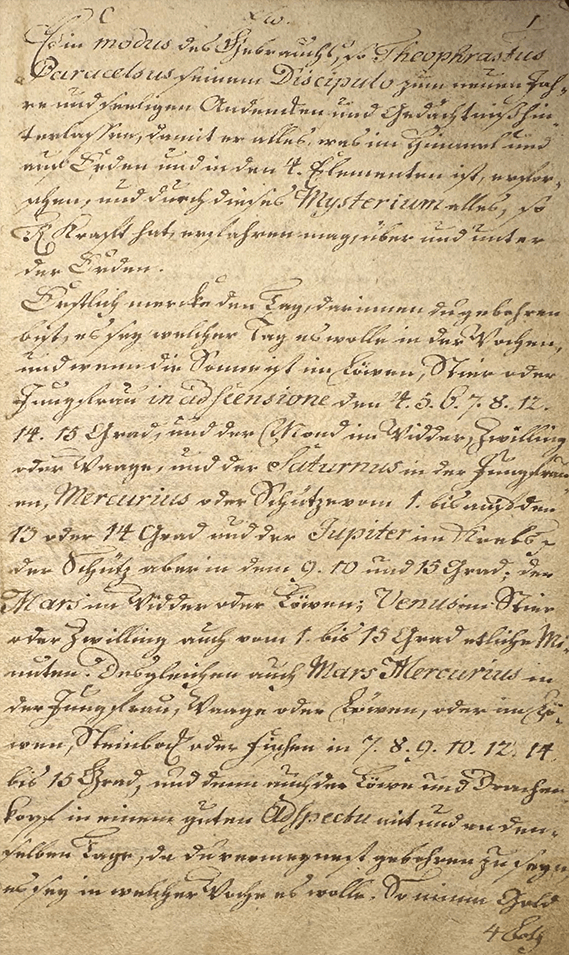Würzbrunn, den 30. August 1735
The Büchlein von Olympischer Geister Citirung is a pseudo-Paracelsian grimoire of the German tradition concerning the conjuration of the Olympic spirits. Ultimately derived from the sixteenth-century Arbatel de Magia Veterum, it represents an early-eighteenth-century vernacular adaptation of Paracelsian-Hermetic angelology framed within a practical ritual format. The work blends Paracelsian philosophy with Solomonic ritualism, presenting the “Olympic” or planetary intelligences as mediating powers through which divine wisdom and natural virtue are accessed.
The Olympic spirits (Oympischer Geister)—a septenary hierarchy corresponding to the seven classical planets—are invoked as rulers of the cosmic spheres:
- Aratron (Saturn),
- Bethor (Jupiter),
- Phaleg (Mars),
- Och (Sun),
- Hagith (Venus),
- Ophiel (Mercury), and
- Phul (Moon).
In early modern magical thought, these were conceived not as demons but as elevated planetary governors or angels of the celestial order, whose powers could be called upon for wisdom, healing, or transformation according to the astrological correspondences of each sphere.
The first thirteen pages of the present manuscript appear to have been copied almost verbatim from Philippi Theophrasti Paracelsi Bombast des Hocherfahrnen, Berühmtesten Philosophie und Adepti Gröstes und höchstes Geheimnüsz aller seiner Geheimnüsse (first printed 1686). This is evident in the distinctive capitalization and orthographic patterns that mirror the printed text. Beyond this opening section, however, the text diverges from its printed source and adopts a distinctly operative tone, combining unique material with elements derived from the Arbatel of Magic and related Solomonic traditions. Unlike the Arbatel, which is composed in aphoristic form, the Büchlein is written in continuous prose and functions as a ritual manual, providing direct instructions for invocation and enumeration of angelic hierarchies.
Later sections describe numerous other angels and their temporal divisions, assigning distinct cohorts of celestial spirits to the hours or quarters of the day—morning, noon, evening, and midnight. These lists include both canonical archangels (Gabriel, Raphael, Samael, Haniel) and rarer names (Copebiti, Moragael, Volaquiel, Tiameubel), corresponding to the traditional planetary or celestial mansions. This practical organization of angels by the hours of the day reflects Heptameron-style operations more than the speculative philosophy of the Arbatel, revealing the work’s hybrid nature: a Paracelsian-Arbatelian cosmology adapted to a Solomonic ritual framework.
The manuscript concludes with a colophon written in the same 18th-century hand, stating: “Würzbrunn, den 30. August 1735.” This provides both a firm date of completion (30 August 1735) and a probable place of copying, Würzbrunn—an abbreviated form of Würzbrunnen, a hamlet in Röthenbach im Emmental (Canton Bern, Switzerland). The entry situates the manuscript’s production within the Swiss Paracelsian milieu rather than the Franconian center of Würzburg, confirming its origin in the broader German-Swiss grimoire tradition of the early eighteenth century.
The Büchlein thus stands at the intersection of Paracelsian natural philosophy and Christian-Hermetic ritual magic, reflecting the ongoing transmission and vernacularization of Arbatel-derived angelic magic within eighteenth-century Central Europe.





